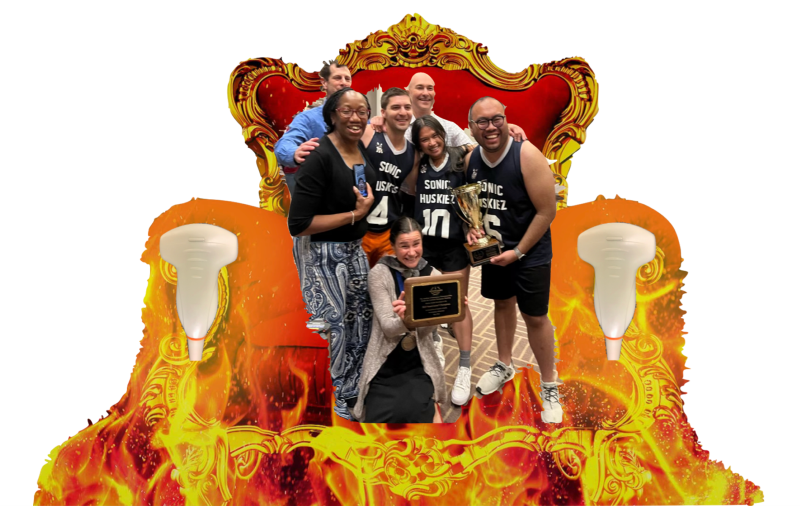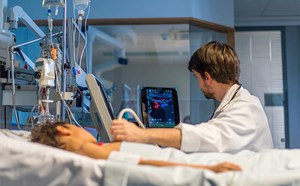
Sono Hot Seat with Meghan Herbst: On Building a SonoGames Team
Meghan K. Herbst MD, FACEP
University of Connecticut
@EUSmkh, @UConnEmergMed
Questions posed by Stephen Alerhand, MD
Q: Your team has won SonoGames twice over the past 10 years. What is your secret?
UConn has always been proud of its ultrasound training. While the talent of other residencies makes winning SonoGames incredibly challenging, I think there may be a few factors that keep us competitive every year.
First, we have dedicated ultrasound faculty across our residency sites who are invested in our residents’ ultrasound education. They have an #ultrasoundfirst mentality and do not shy away from giving real-time focused feedback on technique, image adequacy, and interpretation accuracy.
Second, we choose our SonoGames team according to the highest performers of a three-hour residency-wide SonoGames qualifier held every year in January. We started using a qualifier 10 years ago to promote a fair process for selecting our team, as we didn’t want to choose according to who was pursuing ultrasound fellowships, who was already attending SAEM for other reasons, or who were the obvious ultrasound “gunners.” The qualifier is a required part of our residency didactics and tests ultrasound knowledge as well as hands-on skills. Questions are created and peer-reviewed by our ultrasound faculty, and the competition has a reputation of being very difficult (and fun!). The top three performing residents (can be any PGY level, any resident) represent UConn at the national SonoGames competition, and our residency covers travel and other costs to support their attendance. Qualifier champions gain a lot of respect and admiration from within our residency, and there is a healthy competitive spirit from year to year around the competition.
Third, the residency program director and assistant residency director are avid users of ultrasound. Their skill and incorporation of ultrasound as part of their daily clinical practice set the bar high for our large residency. They prioritize ultrasound education, and their sono-enthusiasm has a ripple effect on other core faculty.
Finally, our residency has a strong alliance with medical education. Many of our residents participate in near-peer education across our required vertical undergraduate medical education ultrasound curriculum. There are opportunities for our residents to teach as frequently as every month. They also create and run a SonoSlam qualifier for our medical students, giving them a sense of what goes into creating questions and stations, and how to score highly in competitions like this.
Q: How are you preparing your SonoGames team for the competition?
In addition to providing a strong ultrasound curriculum for all residents, and the creation of an annual residency-wide SonoGames qualifier structured similar to the national SonoGames competition, our SonoGames team is encouraged to study independently, attend weekly ultrasound video reviews already held for ultrasound rotators, and work on team-building. This year, we scheduled two sessions with the team and ultrasound faculty to play some ultrasound games and practice answering questions as a team (with the focus on team-building/communication). We also traditionally treat our team to breakfast the morning of the games, run through some questions and images, and offer a brief pep talk to instill confidence.
Q: Is there training specific to SonoGames, or just POCUS education in general built up over the years? How are these structured?
Most training is part of the residency curriculum and open to all residents. Our residency curriculum consists of a 16-hour ultrasound course during residency orientation, several year-directed three-hour application-focused ultrasound sessions during each year of residency, monthly residency-wide ultrasound image based didactics (with additional optional image reviews after conference), two 2-week formal ultrasound rotations (one during first year and one during second year) prioritizing scanning and image review, a longitudinal asynchronous curriculum consisting of QA at clinical ED sites (one site provides QA on 100% of ultrasounds performed), and we additionally require the residents to log more ultrasounds than ACEP recommendations, including 100 biliary ultrasounds and at least 500 ultrasounds total, in order to graduate. Our current residents (PGY1-PGY3) have collectively logged an average of 596 ultrasounds to date, and the highest logged is 2500.
The only SonoGames team-specific training are the two sessions mentioned above. They both took place in the evening over pizza. We (ultrasound faculty) created questions, ultrasound challenges, brought board games, and made foreign body phantoms for the team to practice working on together. The communication and team-building piece is essential, especially given the individuals were chosen based on individual performance in our qualifier. Developing these questions and games also serves as a creative outlet for the ultrasound faculty and promotes stronger residency-faculty bonds that may even inspire these residents to pursue ultrasound fellowships and become future ultrasound leaders.
Q: Are all your residents so stellar, or is it only this upper tier of US-interested residents?
Most of our residents are strong, and many are stellar. Given the value our residency places on ultrasound year-round, its importance in clinical care, and its value in medical education, our residents uniformly strive to achieve high proficiency in this skill. Because the SonoGames qualifier is highly competitive, promotes the highest performing (and not necessarily the most interested) residents, and scores within the top half of the residency are close, those who make it on the team have confidence that their ultrasound skills and knowledge will allow them to compete well on a national level.



